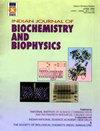Solution structures and thermodynamics of cis-trans X-Pro conformers of a novel single disulfide conopeptide
IF 1.5
4区 生物学
Q4 BIOCHEMISTRY & MOLECULAR BIOLOGY
引用次数: 0
Abstract
The conopeptide Mo1853 (MW = 1853 Da) consists of 17 residues and a single disulfide bond. Structural studies using homonuclear solution NMR methods (2D 1H,1H DQF-COSY, TOCSY, NOESY and ROESY spectra) revealed that Mo1853 exists as two equally populated cis and trans X–Pro peptide bond conformers which are in slow exchange regime, compared to the chemical shift time scale. Temperature dependence of chemical shifts was measured and using coalescence temperature of two amide protons, the rate of exchange and the free energy of activation for the conformational exchange were determined to be 59 Hz and ≈ 67.2 kJ mol−1, respectively, at 318 K. Additional evidence for this conformational equilibrium was also observed as exchange correlation peaks in the 2D-NOESY and ROESY spectra. Tertiary structures of both the cis (PDB ID 8K3N) and trans (PDB ID 8K3M) conformers were determined using distance restraints, backbone dihedral angle restraints, the disulfide bond restraint and the cis or trans conformation of the X–Pro peptide bond. The trans conformer of Mo1853 is stabilized by hydrogen bonds while the cis conformer seems to be stabilized predominantly by hydrophobic interactions. This was further corroborated by the fact that at lower temperatures, the hydrophobic interactions became weaker reducing the population of the cis conformer with respect to that of the trans conformer. The cis and trans X–Pro peptide bond conformational exchange could be another means to enhance the structural variability of the conopeptides and could have significance in the synergistic functional response caused by the cone snail venom peptides.一种新型单二硫共聚肽顺反X-Pro构象的溶液结构和热力学
共肽Mo1853 (MW = 1853 Da)由17个残基和一个二硫键组成。利用同核溶液NMR方法(2D 1H,1H DQF-COSY, TOCSY, NOESY和ROESY光谱)进行的结构研究表明,与化学位移时间尺度相比,Mo1853以两个均匀分布的顺式和反式X-Pro肽键构象存在,处于缓慢交换状态。测量了化学位移的温度依赖性,并利用两个酰胺质子的聚结温度,确定了在318 K下的交换速率为59 Hz,构象交换的自由激活能为≈67.2 kJ mol−1。在2D-NOESY和ROESY光谱中的交换相关峰也观察到这种构象平衡的其他证据。顺式(PDB ID 8K3N)和反式(PDB ID 8K3M)构象的三级结构通过距离约束、主二面角约束、二硫键约束和X-Pro肽键的顺式或反式构象来确定。Mo1853的反式构象是由氢键稳定的,而顺式构象似乎主要是由疏水相互作用稳定的。在较低的温度下,疏水相互作用变得更弱,顺式构象的数量相对于反式构象的数量减少。顺式和反式X-Pro肽键的构象交换可能是增强con多肽结构变异性的另一种手段,在锥螺毒液肽引起的协同功能反应中可能具有重要意义。
本文章由计算机程序翻译,如有差异,请以英文原文为准。
求助全文
约1分钟内获得全文
求助全文
来源期刊

Indian journal of biochemistry & biophysics
生物-生化与分子生物学
CiteScore
2.90
自引率
50.00%
发文量
88
审稿时长
3 months
期刊介绍:
Started in 1964, this journal publishes original research articles in the following areas: structure-function relationships of biomolecules; biomolecular recognition, protein-protein and protein-DNA interactions; gene-cloning, genetic engineering, genome analysis, gene targeting, gene expression, vectors, gene therapy; drug targeting, drug design; molecular basis of genetic diseases; conformational studies, computer simulation, novel DNA structures and their biological implications, protein folding; enzymes structure, catalytic mechanisms, regulation; membrane biochemistry, transport, ion channels, signal transduction, cell-cell communication, glycobiology; receptors, antigen-antibody binding, neurochemistry, ageing, apoptosis, cell cycle control; hormones, growth factors; oncogenes, host-virus interactions, viral assembly and structure; intermediary metabolism, molecular basis of disease processes, vitamins, coenzymes, carrier proteins, toxicology; plant and microbial biochemistry; surface forces, micelles and microemulsions, colloids, electrical phenomena, etc. in biological systems. Solicited peer reviewed articles on contemporary Themes and Methods in Biochemistry and Biophysics form an important feature of IJBB.
Review articles on a current topic in the above fields are also considered. They must dwell more on research work done during the last couple of years in the field and authors should integrate their own work with that of others with acumen and authenticity, mere compilation of references by a third party is discouraged. While IJBB strongly promotes innovative novel research works for publication as full length papers, it also considers research data emanating from limited objectives, and extension of ongoing experimental works as ‘Notes’. IJBB follows “Double Blind Review process” where author names, affiliations and other correspondence details are removed to ensure fare evaluation. At the same time, reviewer names are not disclosed to authors.
 求助内容:
求助内容: 应助结果提醒方式:
应助结果提醒方式:


